Kuro: The Color Black in Chanoyu Part 2
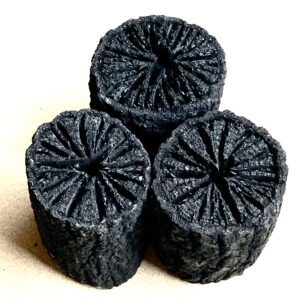
In Chanoyu, according to Buddhist tradition, venerated objects are displayed on elevated stands and altars, which are customarily lacquered black. These pieces of furniture are frequently adorned with gold lacquer to reflect light. Black in the Asian tradition is the color of joy.
The nobility and aristocracy are deemed above the common mankind, hence are called ‘your highness’. Deities are regarded as celestial in heaven, and mountains being closer to heaven, are themselves deemed divine. Many sacred mountains identified as female are forbidden even to the devout clergy. Mount Kailash in Tibet is such a sacred place, that no one is allowed to climb her. It is a place only for the gods, and Indra the king of the gods and the kings of the four directions reside there. Indra in Japan is known as Tai-shaku-ten, 帝釈天, Emperor-explain-heaven (Deva). Kailash is believed to be the earthly manifestation of the sacred Mount Sumeru, Shu-mi-sen, 須弥山, Necessarily-increase-mountain, which is the center of the world of the Buddhist altar called the Shumidan.
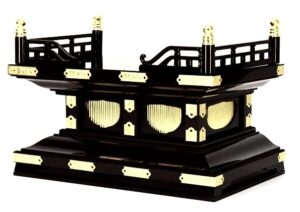
Things of importance are elevated above the norm. This is especially true with Tea utensils. Seemingly contrary, when handling a precious object, it is held closer to the floor. The more revered, the closer to the floor. The elevation of utensils is appropriate when presenting something to a person of nobility or stature called a ki-nin, 貴人, esteem-person. The floor of most tokonoma is raised above the level of the floor in the connecting room. This is to show and demonstrate the importance of the scroll and flowers and other highly regarded objects. The origin of the tokonoma includes the raised floor where the nobility sits, and even sleeps in former times. The height of the floor of the tokonoma stems from the custom of placing tatami mats on top of the existing tatami. Additional tatami are stacked upon the others, depending on the stature of the individual. In the instance of the customary tokonoma, the front edge of the stacked tatami is covered by a wooden beam called a kamachi, 框.
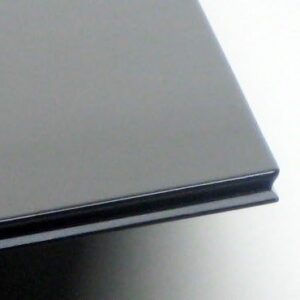
Ya-hazu ita, 矢筈板, arrow-nock board, rectangular wooden board with grooved edge, and fully lacquered black with mirror-finish, shin nuri, 真塗, true-lacquer; 14 x 9 sun kane-jaku. This usu-ita, 薄板, thin-board, is used to display a formal hana-ire, 花入, flower-receptacle: Chinese bronze, porcelain, ceramic, etc.
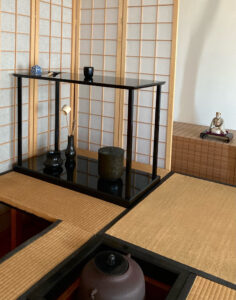
The daisu is modeled after the shumidan, which is manifest in the shape of the edges of the two boards.
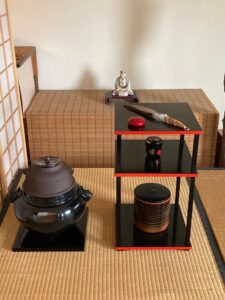
Kō-kō-dana, 更好棚, again-chose-shelf, ni-ju-dana, 二重棚, two-tier-shelf, with four posts, and lacquered black throughout with shelf edges trimmed in tsuma-gure, 爪紅, nail-red, choice of Gen-gen-sai, 玄々斎, Mystery-mystery-abstain, XI Iemoto, Urasenke. Photographed with ki-men bu-ro, 鬼面風炉, demon-face wind-hearth, supported on a shiki-ita, 敷板, spread-board, black-lacquered wooden board. The protective shiki-ita has its counterpart in the ro-buchi, 炉縁, hearth-frame. The display stand is also used with the ro.
The name ‘again-chose’ refers to Gengensai being inspired by Rikyū’s plain wood san-jū-dana, 三重棚, three-tier-shelf. He had the top shelf removed, as it was not used to display utensils for making tea, and had the stand lacquered black. Rikyū’s three-shelf stand, was actually an adaptation of the stand with five shelves that was used in the mizuya to help organize utensils used in the service of the meal, kai-seki, 懐石, heart-stone.
The maru-joku, 丸卓, round-stand, has the upper shelf supported on two splat posts, and is lacquered black throughout; and is the choice of Sen Sō-tan, 千宗旦, Thousand Sect-dawn, grandson of Rikyū, and founder of the three Sen families. The display stand is a variation of a sake barrel used by Sōtan, which he eventually had it lacquered black by I-kkan, 一閑, One-idler. The word joku is used for a display stand borrowed from another purpose; the original joku was a stand for an incense burner. The maru-joku was photographed with the ro, and is also used with the furo.
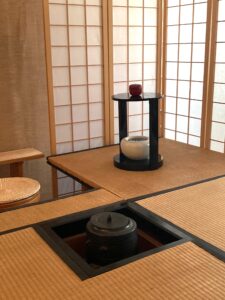
In the ro is a black, iron kama, 釜, kettle. The black-lacquered ro-buchi, 炉縁, hearth-frame, plays a role of protecting the surrounding tatami, just as the black-lacquered shiki-ita, 敷板, spread-board, for the furo. The width of the upper surface of the robuchi is the same as the black fabric heri, 縁, edge, of the tatami.
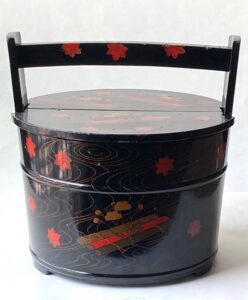
Te-oke, 手桶, handle-bucket; wooden vessel with upright coops and cross-handle, three low feet, with wari-buta, 割蓋, divide-lid, and with shin-nuri, 真塗, true-paint, mirror-finished black-lacquered throughout with red and gold lacquer design of hana-ikada, 花筏, flower-raft. When the bucket is used with fu-ro, 風炉, wind-hearth, the bucket should have two feet as shō-men, 正面, true-face, because the furo has one foot forward. When used with the ro, 炉, sunken hearth, one foot is shōmen. Rikyū used a black-lacquered teoke with the shin daisu. The teoke may be used to display the hi-shaku, 柄杓, handle-ladle, and the futa-oki, 蓋置, lid-place, at the conclusion of the ten-mae, 點前, offer-fore. Because the bucket is a water source, it is not refilled at the end of the Tea presentation.
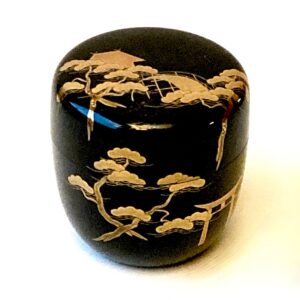
Cha-ki, 茶器, tea-container, is a generic term for a wide variety of tea containers, that are made of lathe-turned wooden covered containers, and frequently covered with mirror-finish black lacquer. Gold, silver, and color enamel decorations often adorn the containers. Standard forms include the ovoid natsume, 棗, jujube, and the cylindrical naka-tsuki, 中付, middle-join, and are used in preparing both koi-cha, 濃茶, thick-tea, and usu-cha, 薄茶, thin-tea, and their multiple variations. The most frequently used chaki is the Rikyū-gata chū-natsume, 利休形中棗, Rikyū-shape middle-jujube, that is entirely lacquered black.
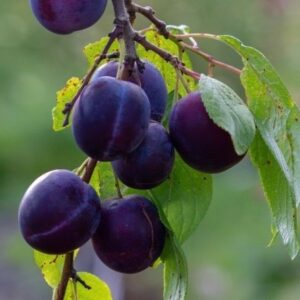
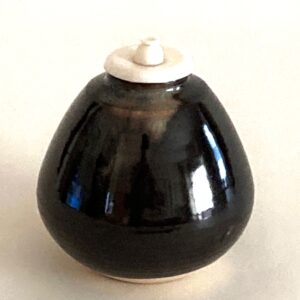
Cha-ire, 茶入, tea-receptacle, is a ceramic jar in a form called nasu, 茄, eggplant, with black glaze. It is a Japanese adaptation of a Chinese Kara-mono cha-ire, 唐物茶入, Tang-thing tea-receptacle, with an ivory lid in the form of a hei-shi buta, 瓶子蓋, bottle-of lid.
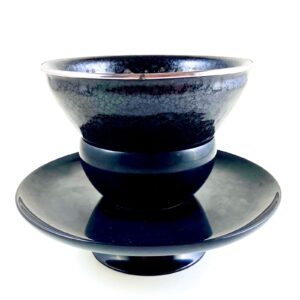
Ten-moku cha-wan, 天目茶碗, Heaven-eye tea-bowl, ceramic conical bowl with black glaze, yu-teki, 油滴, oil-drip. Japanese adaptation of Chinese tea bowl, with silver fuku-rin, 覆輪, cover-ring, by Oke-tani Tei-ichi, 桶谷定一, Bucket-valley Establish-one, Kyōto. Bowl supported on a black-lacquered ten-moku dai, 天目台, heaven-support of, three-part stand made to raise a Tenmoku chawan, that is named for a location in China where the teabowls are said to have originated. There are seven classic styles of Tenmoku dai, black is the standard. Plain wood dai modeled on the Tenmoku dai used when offering Tea to Shintō deity or the aristocracy – ki-nin, 貴人, noble-person.
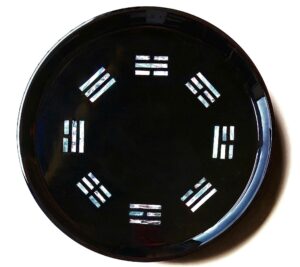
In the exceptional Tea presentation of Gyō, 行, Transitional, a plain wood and bamboo stand, take dai-su, 竹台子, bamboo support-of, is used to display Tea utensils. The hakke bon is placed in the middle of the top shelf, which is identified as ten-ita, 天板, heaven-board. The Karamono chaire is placed in the center of the hakke bon, 八卦盆, eight-signs tray. Before the presentation, the chaire is moved to the right onto the trigram Shin, 震, Thunder, and the Daitenmoku chawan is placed on the left trigram Da, 兌, Lake.
There are many black-lacquered bon, 盆, trays, used in Chanoyu, including those that support various Tea utensils, large and small, moist or dry sweets, etc. Some trays are plain, others highly decorated with gold and color lacquer designs. Perhaps the most symbolic black lacquered tray is the ha-kke bon, 八卦盆, eight-signs tray, with inlaid mother-of-pearl, ao-gai, 青貝, blue-shell, trigrams of the Eki-kyō, 易経, Change-sutra, I Ching.
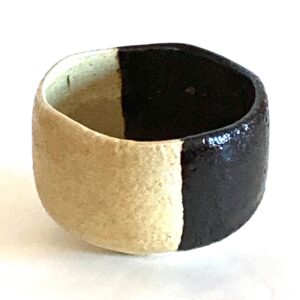
Cha-wan, 茶碗, tea-bowl, ceramic bowl with glazed half black and half white, called kake-wake, 掛分, hang-divide, by Ryō-Raku, 良楽, Good-pleasure, alternate name of Sa-sa-ki Shō-Raku, 佐々木松楽, Help-help-tree Pine-pleasure; diam. 4 sun kane-jaku. Black is enhanced when accompanied by a contrasting color or gold. The chawan that is half black and half white, may evoke thought of the changing moon, and the chawan is identified with the moon. The chaire is identified with the sun.
Cha-sen, 茶筅, tea-whisk, has kuro-ito, 黒糸, black-thread, wound around the whisk that helps separate the outer tines from the inner tines. Some Tea utensils have black thread wound around handles to secure bamboo sheathing. Some chasen used in Tea offerings often have white threads tied around the whisk.
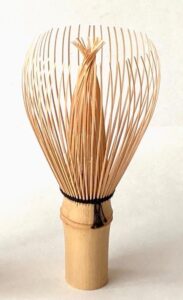
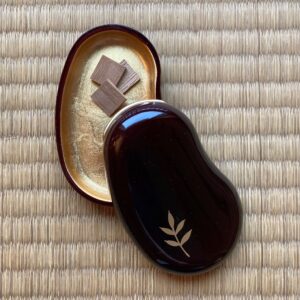
Yō-ji-ire, 楊枝入, willow-twig-receptacle, black-lacquered, covered container lined in gold, in the form of an o-ta-fuku mame, お多福豆, o-much-fortune. The black, aged, large broad beans are boiled with their skins in a tetsu-gama, 鉄釜, iron-pot, until sweet and blackened. The leafy design suggests nan-ten, 南天, south-heaven, nandina, used in Chinese medicine to dispel illness. The container is suitable as a kō-gō, 香合, incense-gather, for use with the furo.
Kuro mame, 黒豆, black-bean, cooked with rusty iron nail for color and a sweet flavor. The key technique is to cook the beams without breaking the skin. Black beans are an essential part of the New Year’s meal called O-sechi, お節, Hon.-season.
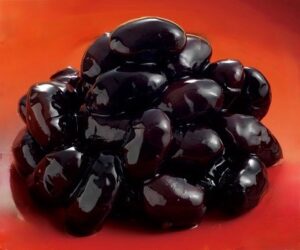
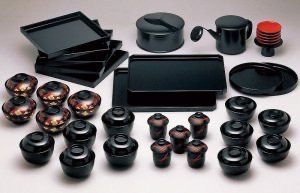
In the realm of Cha-no-yu, 茶の湯, Tea-’s-hot water, many utensils are made of wood that are covered with black lacquer that have a mirror-finish called shin-nuri, 真塗, true-coating. These include display stands, boards, cabinets, etc. and bowls, trays, covered containers, etc., which are often used presenting a meal in a Cha-ji, 茶事 Tea-matter.
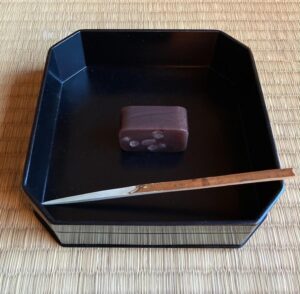
Fuchi-daka, 縁高, edge-high; W. 5.5 sun kane-jaku, one of a stack of boxes with chamfered corners for serving foods and tea sweets, with a slice of yō-kan, 羊羹, sheep-stew, sweetened bean gel, and wooden pick, kuro-mo-ji, 黒文字, black-letter-character; L. 6 sun kane-jaku. Yō-kan, 羊羹, sheep-stew, is sweetened bean gel that can be kept for a long time, and that is an essential sweet for Tea. A variety of yōkan is kuro-neri, 黒煉り, black-kneaded.
The fuchidaka tray and the lacquered sanbō tray have nine sides: the bottom and the eight sides. Both have four long sides and four short sides. Each long side measures 4 sun kane-jaku, and each short side measures one sun kane-jaku. Collectively, the lengths of one long side and one short side equal 5 sun kane-jaku. There are many utensils used in Chanoyu that manifest the relationship of 5 and 9.
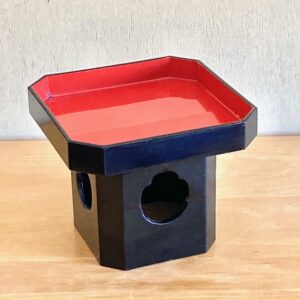
Black-lacquered san-bō, 三宝, three-treasures, a tray affixed to a narrower stand with three openings on the base, that is used in Buddhist and Shintō offerings. The chamfered corners gives the object eight sides, which is symbolic of Infinity in Space. The width of the tray is 5.5 sun kane-jaku. The vermilion-lacquered interior of the black sanbō is a common feature of containers for food. Both red and black are believed to dispel evil and illness. Traditional Japanese lacquerers measure objects with the larger kujira-jaku, 鯨尺, whale-span, so that both lacquered trays may by 4.4 sun kujira-jaku. The fuchidaka tray is the same size as the tray of the sanbō, which exhibits the origin of the fuchidaka. In general, lacquered objects are prevalent in Buddhism, whereas plain wooden objects are associated with Shintō.
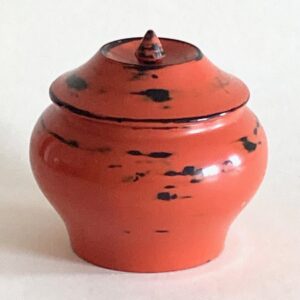
Ya-kki, 薬器, medicine-container, originally lacquered black throughout, with a thin layer of vermilion lacquer for economical reasoning. Through use, the red lacquer wore away revealing the black lacquer beneath. This type of lacquering is identified with Ne-goro-ji, 根来寺, Root-cause-temple, and lends itself to a feeling of wabi, 侘び, timeworn.
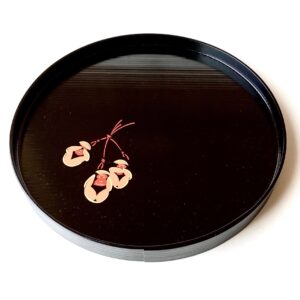
Hi-ga-shi bon, 干菓子, dry-sweet-of; wooden maru-bon, 丸盆, round-tray, black-lacquered throughout with color design of ceramic bells in the form of mi-zaru, 三猿, three-monkeys; diam. 7.3 sun kane-jaku or 5.8 sun kujira-jaku, by Zō-hiko, 象彦, Elephant-lad. The three monkeys is wordplay on mi-zaru, 見ざる, see-not, iwa-zaru, 言わざる, speak-not, kika-zaru, 聞かざる. The word zaru is a homophone for ‘not’ and for ‘monkey’.
The ideal diameter of the higashi bon is 8 sun kane-jaku, which is a counterpart to the 8-sun kyū-ji-bon, 給仕盆, serve-attend-tray, used by the teishu when serving foods in a Chaji. The tray has a gallery of bentwood, mage-mono, 曲物, bend-thing, with the overlapping seam, toji-me, 綴じ目, bind-eye, seam at the front, shō-men, 正面, true-face. This follows the rule of seams on trays: maru-mae ー kaku-mukō, 丸前ー角向こう, round-front ー cornered-opposite.
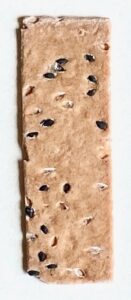
So-ba ita, 蕎麦板, buckwheat-wheat board, sweetened buckwheat wafer baked with embedded kuro go-ma, 黒胡麻, black foreign-hemp; L. 1.8 sun kujira-jaku, by O-wari-ya, 尾張屋, Tail-stretch-house, Kyōto. Excellent hi-ga-shi, 干菓子, dry-sweet-of, for Chanoyu.
Kuro go-ma, 黒胡麻, black foreign-hemp, black sesame seeds are used in cooking, go-ma dō-fu, 胡麻豆腐, sesame bean-ferment, and are sprinkled on baked sweets, etc.
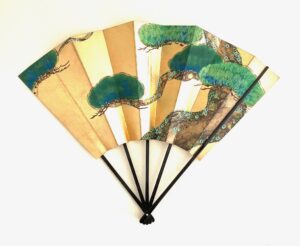
Sen-su, 扇子, fan-of, folding fan made of heavy paper, sen-men, 扇面, fan-face, with a color design of a five-branch kuro-matsu, 黒松, black-pine, on a gold ground; L. 10 sun kujira-jaku or 12.5 sun kane-jaku – length of this senmen is 7 sun kane-jaku, and the exposed rib length is 5 sun kane-jaku.
The numbers 5 and 7 manifest the aspect of Yō, 陽, Yang, positive, because each number cannot be equally divided in half. The five black-lacquered ribs, sen-kotsu, 扇骨, fan-bone, support the sen-men, 扇面, fan-face, that is divided into nine panels of paper. The numbers 5 and 9 are found in various Tea utensils, for example, the length of the kazari hi-bashi, 飾り火箸, display fire-rods, is 9.5 sun kane-jaku.
The pine is so-called because of its black bark, and the kuromatsu is a design often present on cha-dō-gu, 茶道具, tea-way-utensils. Such fans are for display or in theater performance, and would be suitable for display in the tokonoma of the machi-ai, 待合, wait-gather, where guests assemble before a Tea presentation. The display in the maichiai tokonoma presents the theme of the Tea gathering.
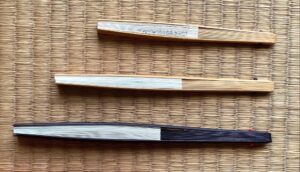
The folding fan, sen-su, 扇子, fan-of, is synonymous with Japan, and a sensu is essential to a person who is a participant of Chanoyu. The length of the sensu is determined: for women – 5 sun kane-jaku, for men – 6 sun kane-jaku, and for a more elevated person, such as a teacher – 7 sun kane-jaku.
Sensu are used in Buddhism to distinguish boundaries, some have sutras written on them. The sensu is an often-used tool in theater, especially dance. Decorated sensu are admired simply for their beauty. The folding sensu is a manifestation of sue-hiro, 末広, ends-wide, which is symbolic of Infinity in Space. Many sensu have black-lacquered ribs, sen-kotsu, 扇骨, fan-bone. Other than the fore mentioned sensu, there are millions of sensu used primarily for fanning oneself. Among multitude of sensu, some are all black, or have black ribs.
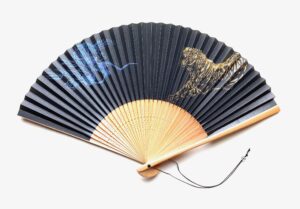
Sen-su, 扇子, fan-of, black paper sen-men, 扇面, fan-face, with a design of a dragon and a tiger. The fan, excluding the two covers, has 32 ribs, which is the number of petals on the Japanese imperial crest, and is symbolic of the 32 directions, omnipresence. The mythical dragon is a manifestation of the aspect of Yō, 陽, positive, whereas the corporeal tiger is a manifestation of the aspect of In, 陰, negative. According to Asian lore, the dragon, Sei-ryū, 青龍, Blue-green dragon, guards the east, the tiger, Bya-kko, 白虎, White-tiger, guards the west.
For further study, see also: Kuro: The Color Black in Chanoyu Part 1 and Rikyū Chū Natsume

